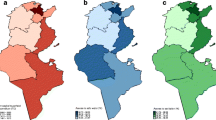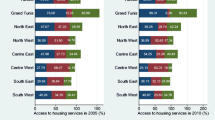Abstract
The universally used socioeconomic indices like education and housing indicators (access to water, sanitation and electricity) appraise solely the coverage level of basic opportunities in a society without capturing the differential intensity across various subgroups. This paper provides a new application of the known Human Opportunity Index (HOI) in order to assess the inequality in distribution of basic services at regional scale in one of the MENA’s most unequal countries. Based on the differentiation between circumstance and effort variables in John Roemer’s theory, we correlate inequality of opportunities with seven observed circumstances which are not controllable by individuals. Logistic regressions required to calculate various HOI indexes are used to estimate the contribution of main socioeconomic and demographic circumstances. Large and significant disparities particularly in access to safe water and sanitation have been detected between the eastern (littoral) and western (inland) areas. The residence area, the education level of household head and the per capita household expenditure were the most important circumstances causing such regional disparities. The paper affords also some potential policy implications through the HOI estimation results.






Similar content being viewed by others
Notes
Over the past 25 years, the Gini coefficient for Tunisia has decreased from 0.434 to 0.361 between 1985 and 2010 (World Development Indicators).
National Institute of Statistics of Tunisia (INS), “Mesure de la pauvreté et des inégalités en Tunisie 2000-2010”.
The 2005 National Survey on Households’ Budget, Consumption and Standard of Living can be downloaded from the National Institute of Statistics (www.ins.nat.tn) or from the Economic Research Forum (ERF) open access micro data (www.erfdataportal.com ).
This index is used as an approximate indicator of household living standard.
This region particularly the governorate of Sidi Bouzid was the bed of the Tunisian revolution.
References
Anand, S. (1983). Inequality and Poverty in Malaysia: Measurement and Decomposition. New York: A World Bank Research Publication, Oxford University Press.
Arneson, R. (1989). Equality of opportunity for welfare. Philosophical Studies, 56, 77–93.
Atkinson, A. B. (1970). On the measurement of inequality. Journal of Economic Theory, 2(3), 244–263.
Atkinson, A. B., & Bourguignon, F. (2000). Introduction: income distribution and economics. handbook of income distribution. New York: Elsevier.
Barros, R. P., Ferreira, F. H. G., Molinas Vega, J. R., & Chanduvi, S. (2009). Measuring inequality of opportunity in latin America and the Caribbean. Washington, DC: The World Bank and Palgrave Macmillan.
Bourguignon, F., Ferreira, F., & Menendez, M. (2007). Inequality of opportunity in Brazil. Review of Income and Wealth, 53(4), 585–618.
Chakravarty, S. R. (1990). Ethical social index numbers. New York: Springer-Verlag.
Checchi, D., & Peragine, V. (2010). Inequality of opportunity in Italy. Journal of Economic Inequality, 8(4), 429–450.
Cohen, G. A. (1989). On the currency of egalitarian justice. Ethics, 99, 906–944.
Dworkin, R. (1981). What is equality? part 2: equality of resources. Philosophy and Public Affairs, 10(4), 283–345.
Ferreira, F. H., & Gignoux, J. (2008). Inequality of economic opportunities in latin America. Washington, DC: World Bank.
Ferreira, F. H., & Gignoux, J. (2011). The measurement of inequality of opportunity: theory and an application to Latin America. Review of Income and Wealth, 57(4), 622–657.
Fields, G. S. (2003). Accounting for Income Inequality and its Change: A New Method with Application to U.S. Earnings Inequality. In S. W. Polacheck (Ed.), Research in Labor Economics, Vol 22: Worker Well-Being and Public Policy (pp. 1–38). Oxford: JAI.
Fleurbaey, M. (2008). Fairness, responsibility and welfare. Oxford: Oxford University Press.
Lambert, P. J., & Aronson, J. R. (1993). Inequality decomposition analysis and the gini coefficient revisited. The Economic Journal, 103(420), 1221–1227.
Lefranc, A., Pistolesi, N., & Trannoy, A. (2008). Inequality of opportunities vs. inequality of outcomes: are western societies all alike. Review of Income and Wealth, 54(4), 513–546.
Molina, I., & Rao, J. (2010). Small area estimation of poverty indicators. Canadian Journal of Statistics, 38(3), 369–385.
Molinas, J.R., Barros, R.P., Saavedra, J., Giugale, M., Cord, L.J., Pessino, C., Hasan, A. (2010). Do our children have a chance? The 2010 human opportunity report for Latin America and the Caribbean. Washington, DC: World Bank.
Rawls, J. (1971). A theory of justice. Cambridge: Harvard University Press.
Roemer, J. E. (1993). A pragmatic theory of responsibility for the egalitarian planner. Philosophy and Public Affairs, 22(2), 146–166.
Roemer, J. E. (1998). Equality of opportunity. Cambridge: Harvard University Press.
Sen, A. (1976). Real national income. Review of Economic Studies, 43(1), 19–39.
Sen, A. (1980). Equality of What? Tanner Lectures on Human Values delivered at Stanford University. In McMurrin (Ed.), 1979 Tanner lectures at Stanford. Cambridge: Cambridge University Press.
Silber, J. (1999). Handbook of income inequality measurement. Boston: Kluwer.
Son, H. H. (2013). Inequality of human opportunities in developing asia. Asian Development Review, 30(2), 110–130.
Theil, H. (1967). Economics and information theory. Amsterdam: North-Holland.
Van de Gaer, D. (1993). Equality of opportunity and investment in human capital. PhD dissertation, Catholic University of Leuven, Faculty of Economics, no. 92.
Author information
Authors and Affiliations
Corresponding author
Rights and permissions
About this article
Cite this article
Jemmali, H., Amara, M. Assessing Inequality of Human Opportunities: A New Approach for Public Policy in Tunisia. Applied Research Quality Life 10, 343–361 (2015). https://doi.org/10.1007/s11482-014-9315-5
Received:
Accepted:
Published:
Issue Date:
DOI: https://doi.org/10.1007/s11482-014-9315-5




